International Finance Report: Audi's Risk Management and Performance
VerifiedAdded on 2023/01/05
|12
|3296
|39
Report
AI Summary
This report provides a comprehensive analysis of Audi's international financial environment, risk management strategies, and financial performance. It begins by exploring the impact of the international financial environment, specifically focusing on money markets and short-term interest rates, and their influence on Audi's operations. The report then delves into Audi's risk management strategies, discussing sources of finance and dividend policy, and their effects on the company's growth and stability. Finally, the report evaluates Audi's financial performance using various financial ratios, including gross margin, net profit margin, return on capital employed, trade receivables period, and current ratio. The analysis provides insights into Audi's strengths, weaknesses, and overall financial health, offering recommendations for improvement and future strategies. The report utilizes financial data from 2018 and 2019 to support its findings.
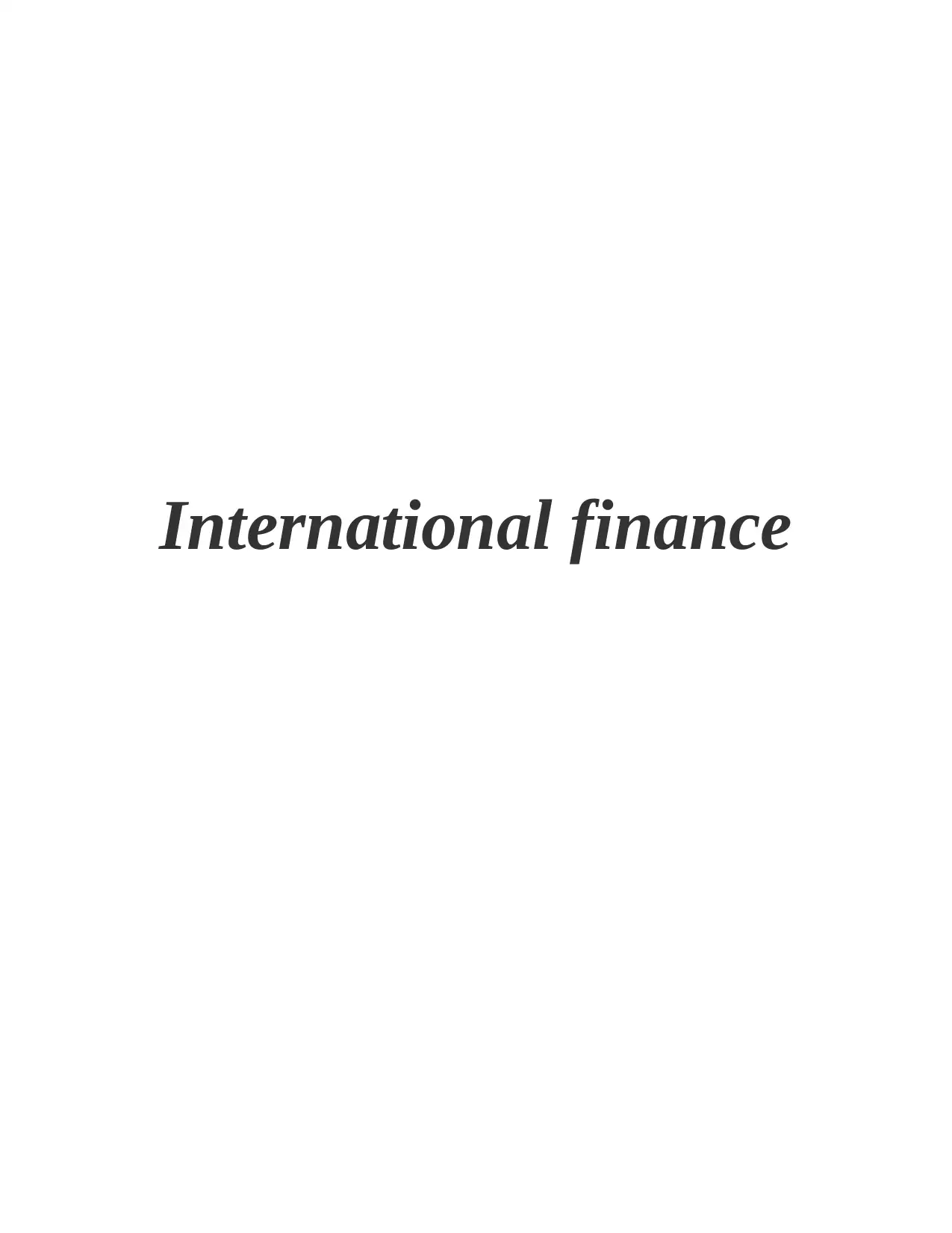
International finance
Paraphrase This Document
Need a fresh take? Get an instant paraphrase of this document with our AI Paraphraser
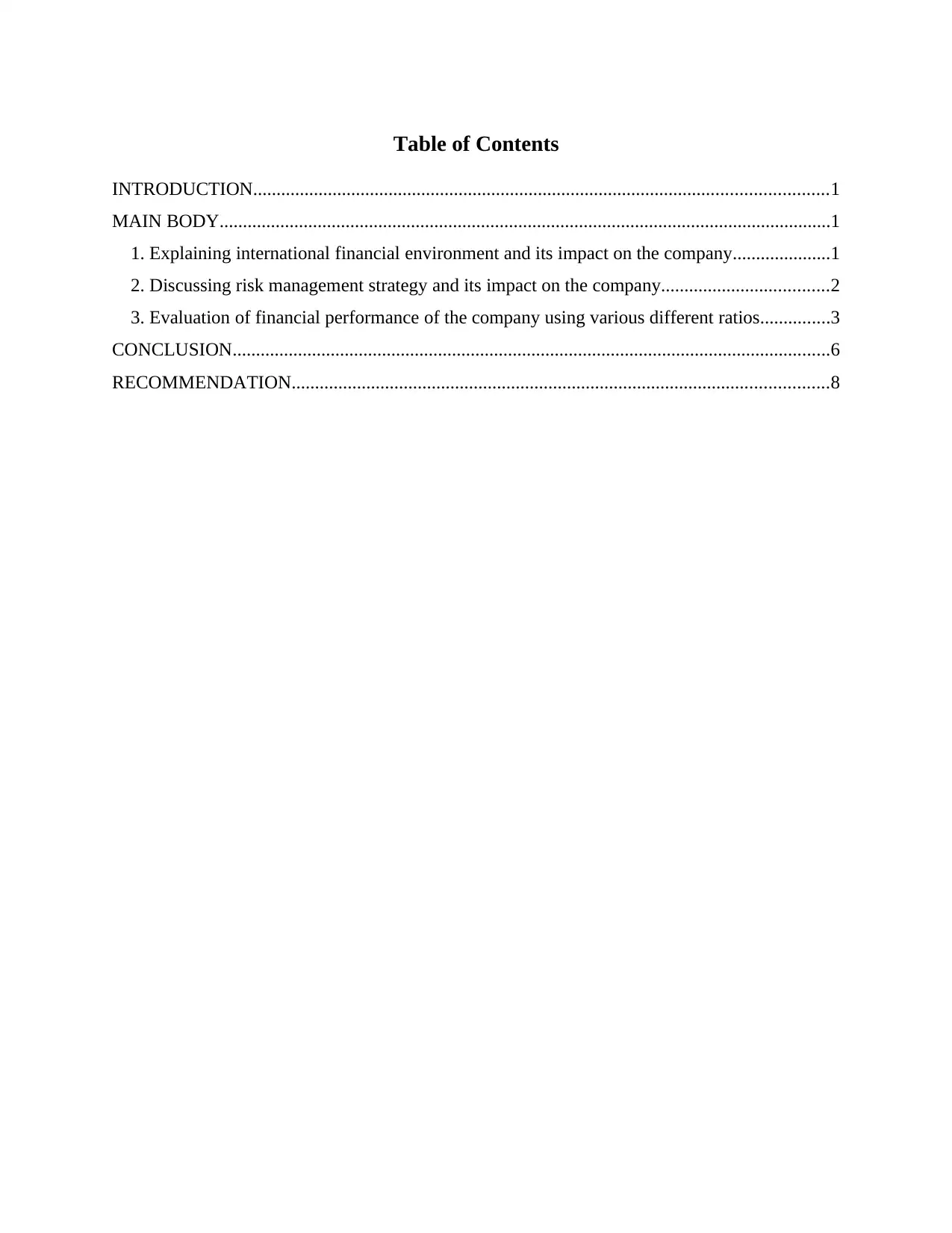
Table of Contents
INTRODUCTION...........................................................................................................................1
MAIN BODY...................................................................................................................................1
1. Explaining international financial environment and its impact on the company.....................1
2. Discussing risk management strategy and its impact on the company....................................2
3. Evaluation of financial performance of the company using various different ratios...............3
CONCLUSION................................................................................................................................6
RECOMMENDATION...................................................................................................................8
INTRODUCTION...........................................................................................................................1
MAIN BODY...................................................................................................................................1
1. Explaining international financial environment and its impact on the company.....................1
2. Discussing risk management strategy and its impact on the company....................................2
3. Evaluation of financial performance of the company using various different ratios...............3
CONCLUSION................................................................................................................................6
RECOMMENDATION...................................................................................................................8
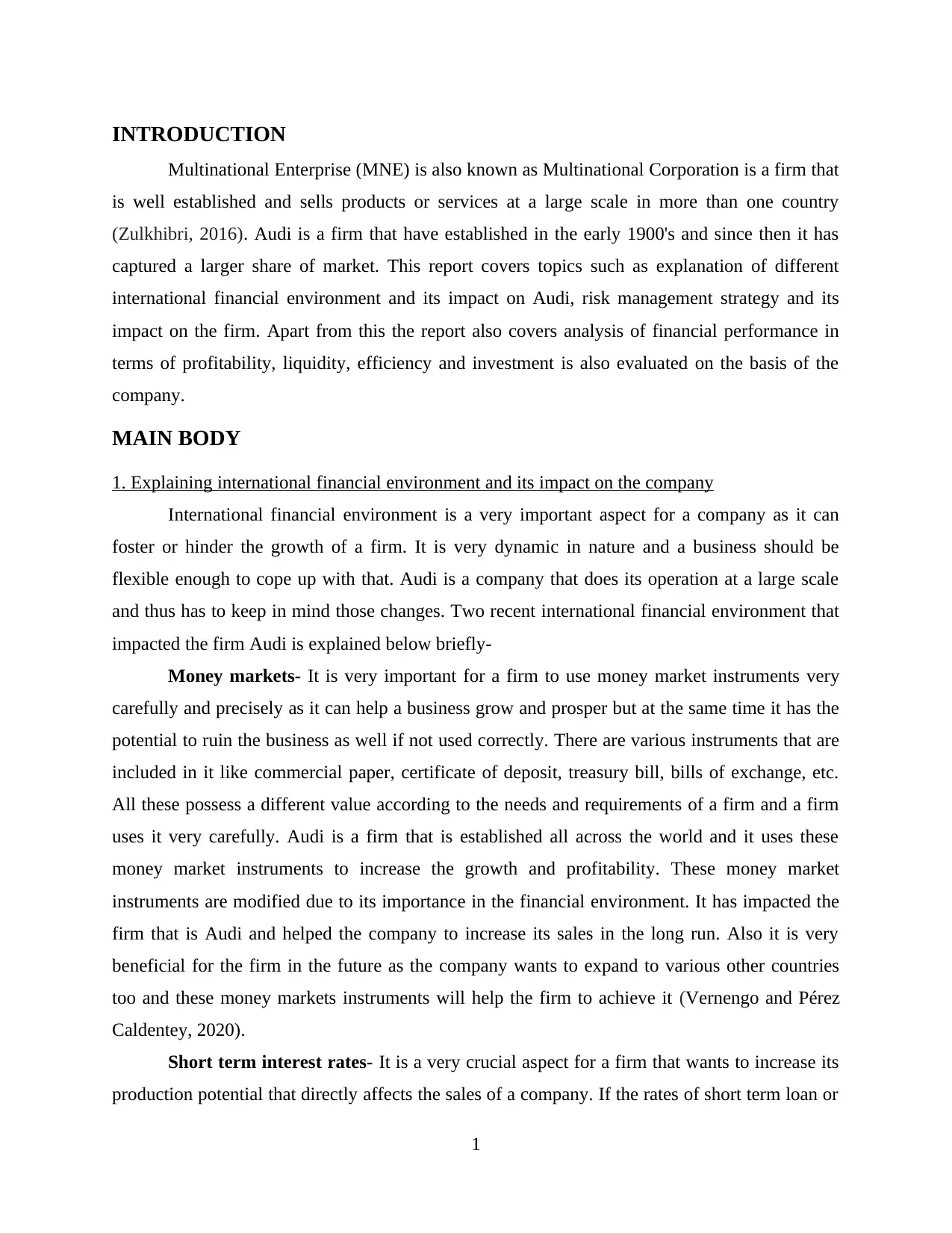
INTRODUCTION
Multinational Enterprise (MNE) is also known as Multinational Corporation is a firm that
is well established and sells products or services at a large scale in more than one country
(Zulkhibri, 2016). Audi is a firm that have established in the early 1900's and since then it has
captured a larger share of market. This report covers topics such as explanation of different
international financial environment and its impact on Audi, risk management strategy and its
impact on the firm. Apart from this the report also covers analysis of financial performance in
terms of profitability, liquidity, efficiency and investment is also evaluated on the basis of the
company.
MAIN BODY
1. Explaining international financial environment and its impact on the company
International financial environment is a very important aspect for a company as it can
foster or hinder the growth of a firm. It is very dynamic in nature and a business should be
flexible enough to cope up with that. Audi is a company that does its operation at a large scale
and thus has to keep in mind those changes. Two recent international financial environment that
impacted the firm Audi is explained below briefly-
Money markets- It is very important for a firm to use money market instruments very
carefully and precisely as it can help a business grow and prosper but at the same time it has the
potential to ruin the business as well if not used correctly. There are various instruments that are
included in it like commercial paper, certificate of deposit, treasury bill, bills of exchange, etc.
All these possess a different value according to the needs and requirements of a firm and a firm
uses it very carefully. Audi is a firm that is established all across the world and it uses these
money market instruments to increase the growth and profitability. These money market
instruments are modified due to its importance in the financial environment. It has impacted the
firm that is Audi and helped the company to increase its sales in the long run. Also it is very
beneficial for the firm in the future as the company wants to expand to various other countries
too and these money markets instruments will help the firm to achieve it (Vernengo and Pérez
Caldentey, 2020).
Short term interest rates- It is a very crucial aspect for a firm that wants to increase its
production potential that directly affects the sales of a company. If the rates of short term loan or
1
Multinational Enterprise (MNE) is also known as Multinational Corporation is a firm that
is well established and sells products or services at a large scale in more than one country
(Zulkhibri, 2016). Audi is a firm that have established in the early 1900's and since then it has
captured a larger share of market. This report covers topics such as explanation of different
international financial environment and its impact on Audi, risk management strategy and its
impact on the firm. Apart from this the report also covers analysis of financial performance in
terms of profitability, liquidity, efficiency and investment is also evaluated on the basis of the
company.
MAIN BODY
1. Explaining international financial environment and its impact on the company
International financial environment is a very important aspect for a company as it can
foster or hinder the growth of a firm. It is very dynamic in nature and a business should be
flexible enough to cope up with that. Audi is a company that does its operation at a large scale
and thus has to keep in mind those changes. Two recent international financial environment that
impacted the firm Audi is explained below briefly-
Money markets- It is very important for a firm to use money market instruments very
carefully and precisely as it can help a business grow and prosper but at the same time it has the
potential to ruin the business as well if not used correctly. There are various instruments that are
included in it like commercial paper, certificate of deposit, treasury bill, bills of exchange, etc.
All these possess a different value according to the needs and requirements of a firm and a firm
uses it very carefully. Audi is a firm that is established all across the world and it uses these
money market instruments to increase the growth and profitability. These money market
instruments are modified due to its importance in the financial environment. It has impacted the
firm that is Audi and helped the company to increase its sales in the long run. Also it is very
beneficial for the firm in the future as the company wants to expand to various other countries
too and these money markets instruments will help the firm to achieve it (Vernengo and Pérez
Caldentey, 2020).
Short term interest rates- It is a very crucial aspect for a firm that wants to increase its
production potential that directly affects the sales of a company. If the rates of short term loan or
1
⊘ This is a preview!⊘
Do you want full access?
Subscribe today to unlock all pages.

Trusted by 1+ million students worldwide
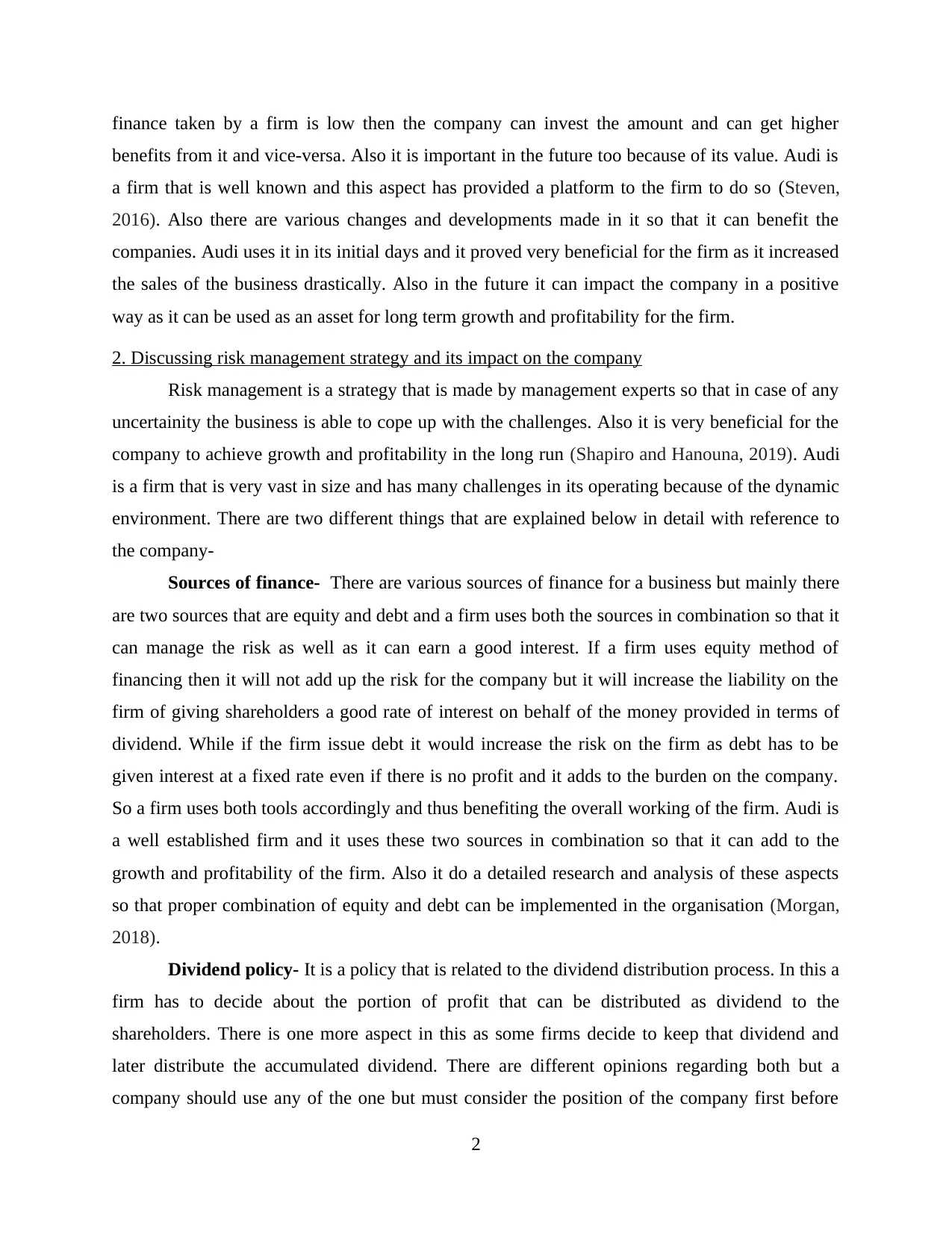
finance taken by a firm is low then the company can invest the amount and can get higher
benefits from it and vice-versa. Also it is important in the future too because of its value. Audi is
a firm that is well known and this aspect has provided a platform to the firm to do so (Steven,
2016). Also there are various changes and developments made in it so that it can benefit the
companies. Audi uses it in its initial days and it proved very beneficial for the firm as it increased
the sales of the business drastically. Also in the future it can impact the company in a positive
way as it can be used as an asset for long term growth and profitability for the firm.
2. Discussing risk management strategy and its impact on the company
Risk management is a strategy that is made by management experts so that in case of any
uncertainity the business is able to cope up with the challenges. Also it is very beneficial for the
company to achieve growth and profitability in the long run (Shapiro and Hanouna, 2019). Audi
is a firm that is very vast in size and has many challenges in its operating because of the dynamic
environment. There are two different things that are explained below in detail with reference to
the company-
Sources of finance- There are various sources of finance for a business but mainly there
are two sources that are equity and debt and a firm uses both the sources in combination so that it
can manage the risk as well as it can earn a good interest. If a firm uses equity method of
financing then it will not add up the risk for the company but it will increase the liability on the
firm of giving shareholders a good rate of interest on behalf of the money provided in terms of
dividend. While if the firm issue debt it would increase the risk on the firm as debt has to be
given interest at a fixed rate even if there is no profit and it adds to the burden on the company.
So a firm uses both tools accordingly and thus benefiting the overall working of the firm. Audi is
a well established firm and it uses these two sources in combination so that it can add to the
growth and profitability of the firm. Also it do a detailed research and analysis of these aspects
so that proper combination of equity and debt can be implemented in the organisation (Morgan,
2018).
Dividend policy- It is a policy that is related to the dividend distribution process. In this a
firm has to decide about the portion of profit that can be distributed as dividend to the
shareholders. There is one more aspect in this as some firms decide to keep that dividend and
later distribute the accumulated dividend. There are different opinions regarding both but a
company should use any of the one but must consider the position of the company first before
2
benefits from it and vice-versa. Also it is important in the future too because of its value. Audi is
a firm that is well known and this aspect has provided a platform to the firm to do so (Steven,
2016). Also there are various changes and developments made in it so that it can benefit the
companies. Audi uses it in its initial days and it proved very beneficial for the firm as it increased
the sales of the business drastically. Also in the future it can impact the company in a positive
way as it can be used as an asset for long term growth and profitability for the firm.
2. Discussing risk management strategy and its impact on the company
Risk management is a strategy that is made by management experts so that in case of any
uncertainity the business is able to cope up with the challenges. Also it is very beneficial for the
company to achieve growth and profitability in the long run (Shapiro and Hanouna, 2019). Audi
is a firm that is very vast in size and has many challenges in its operating because of the dynamic
environment. There are two different things that are explained below in detail with reference to
the company-
Sources of finance- There are various sources of finance for a business but mainly there
are two sources that are equity and debt and a firm uses both the sources in combination so that it
can manage the risk as well as it can earn a good interest. If a firm uses equity method of
financing then it will not add up the risk for the company but it will increase the liability on the
firm of giving shareholders a good rate of interest on behalf of the money provided in terms of
dividend. While if the firm issue debt it would increase the risk on the firm as debt has to be
given interest at a fixed rate even if there is no profit and it adds to the burden on the company.
So a firm uses both tools accordingly and thus benefiting the overall working of the firm. Audi is
a well established firm and it uses these two sources in combination so that it can add to the
growth and profitability of the firm. Also it do a detailed research and analysis of these aspects
so that proper combination of equity and debt can be implemented in the organisation (Morgan,
2018).
Dividend policy- It is a policy that is related to the dividend distribution process. In this a
firm has to decide about the portion of profit that can be distributed as dividend to the
shareholders. There is one more aspect in this as some firms decide to keep that dividend and
later distribute the accumulated dividend. There are different opinions regarding both but a
company should use any of the one but must consider the position of the company first before
2
Paraphrase This Document
Need a fresh take? Get an instant paraphrase of this document with our AI Paraphraser
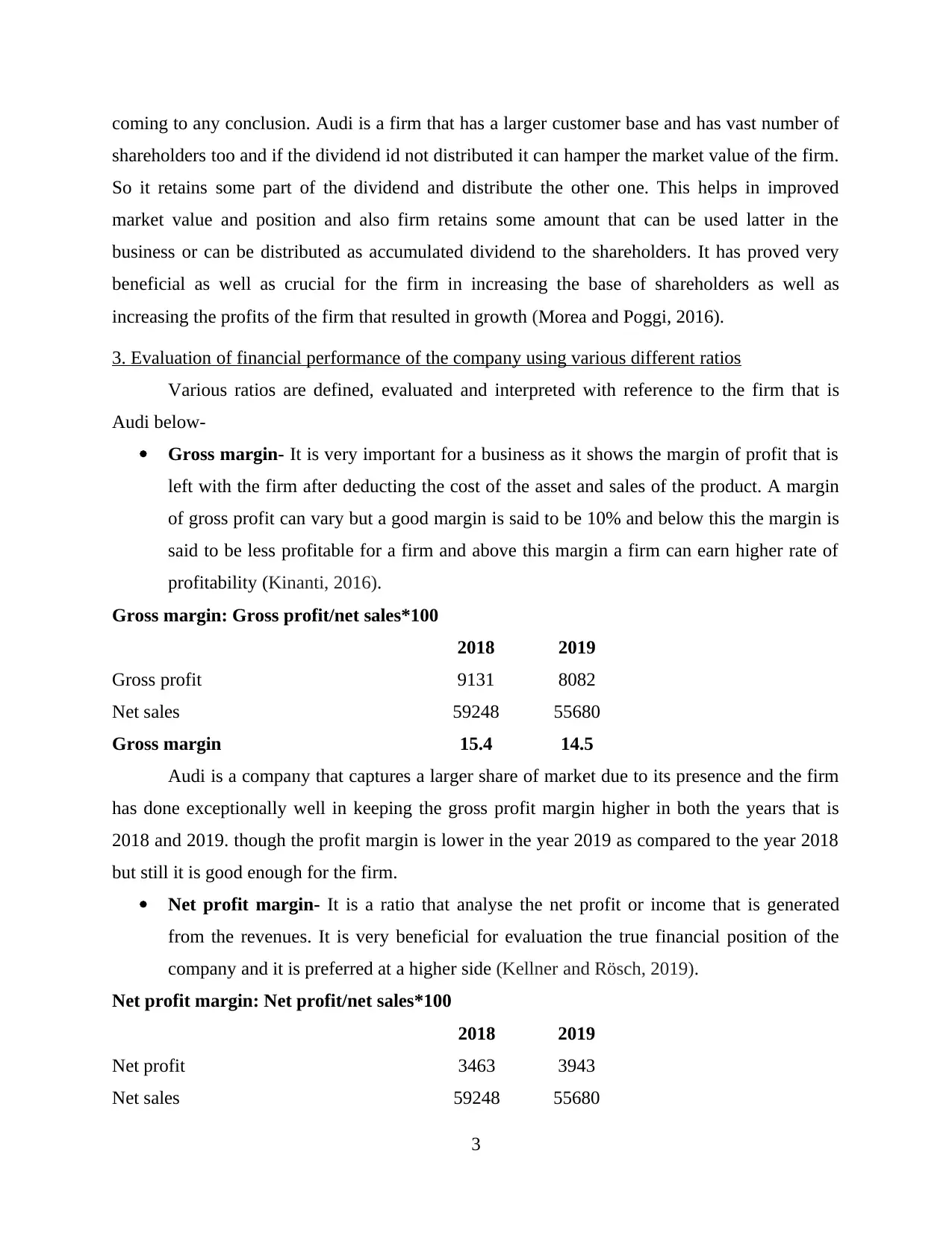
coming to any conclusion. Audi is a firm that has a larger customer base and has vast number of
shareholders too and if the dividend id not distributed it can hamper the market value of the firm.
So it retains some part of the dividend and distribute the other one. This helps in improved
market value and position and also firm retains some amount that can be used latter in the
business or can be distributed as accumulated dividend to the shareholders. It has proved very
beneficial as well as crucial for the firm in increasing the base of shareholders as well as
increasing the profits of the firm that resulted in growth (Morea and Poggi, 2016).
3. Evaluation of financial performance of the company using various different ratios
Various ratios are defined, evaluated and interpreted with reference to the firm that is
Audi below-
Gross margin- It is very important for a business as it shows the margin of profit that is
left with the firm after deducting the cost of the asset and sales of the product. A margin
of gross profit can vary but a good margin is said to be 10% and below this the margin is
said to be less profitable for a firm and above this margin a firm can earn higher rate of
profitability (Kinanti, 2016).
Gross margin: Gross profit/net sales*100
2018 2019
Gross profit 9131 8082
Net sales 59248 55680
Gross margin 15.4 14.5
Audi is a company that captures a larger share of market due to its presence and the firm
has done exceptionally well in keeping the gross profit margin higher in both the years that is
2018 and 2019. though the profit margin is lower in the year 2019 as compared to the year 2018
but still it is good enough for the firm.
Net profit margin- It is a ratio that analyse the net profit or income that is generated
from the revenues. It is very beneficial for evaluation the true financial position of the
company and it is preferred at a higher side (Kellner and Rösch, 2019).
Net profit margin: Net profit/net sales*100
2018 2019
Net profit 3463 3943
Net sales 59248 55680
3
shareholders too and if the dividend id not distributed it can hamper the market value of the firm.
So it retains some part of the dividend and distribute the other one. This helps in improved
market value and position and also firm retains some amount that can be used latter in the
business or can be distributed as accumulated dividend to the shareholders. It has proved very
beneficial as well as crucial for the firm in increasing the base of shareholders as well as
increasing the profits of the firm that resulted in growth (Morea and Poggi, 2016).
3. Evaluation of financial performance of the company using various different ratios
Various ratios are defined, evaluated and interpreted with reference to the firm that is
Audi below-
Gross margin- It is very important for a business as it shows the margin of profit that is
left with the firm after deducting the cost of the asset and sales of the product. A margin
of gross profit can vary but a good margin is said to be 10% and below this the margin is
said to be less profitable for a firm and above this margin a firm can earn higher rate of
profitability (Kinanti, 2016).
Gross margin: Gross profit/net sales*100
2018 2019
Gross profit 9131 8082
Net sales 59248 55680
Gross margin 15.4 14.5
Audi is a company that captures a larger share of market due to its presence and the firm
has done exceptionally well in keeping the gross profit margin higher in both the years that is
2018 and 2019. though the profit margin is lower in the year 2019 as compared to the year 2018
but still it is good enough for the firm.
Net profit margin- It is a ratio that analyse the net profit or income that is generated
from the revenues. It is very beneficial for evaluation the true financial position of the
company and it is preferred at a higher side (Kellner and Rösch, 2019).
Net profit margin: Net profit/net sales*100
2018 2019
Net profit 3463 3943
Net sales 59248 55680
3
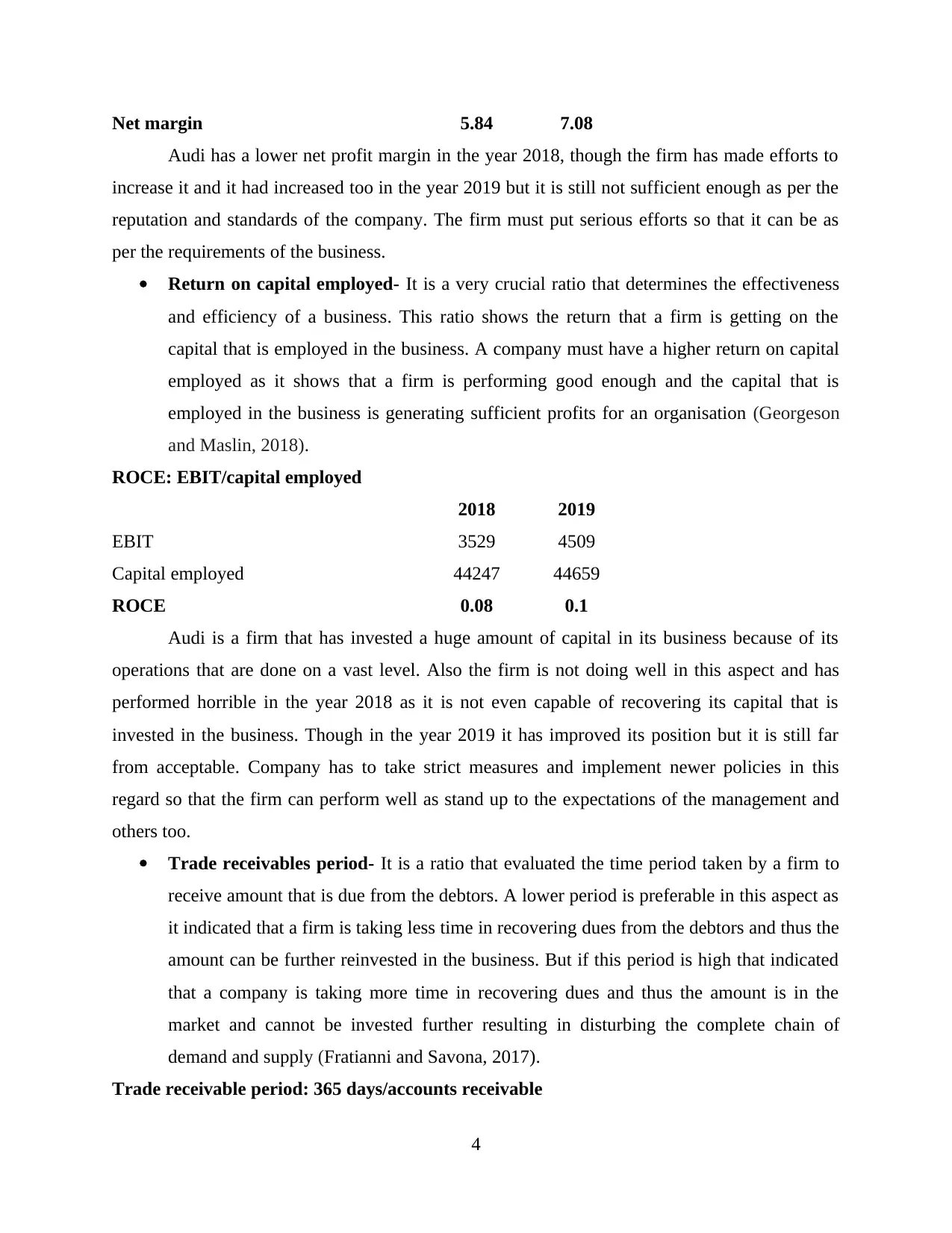
Net margin 5.84 7.08
Audi has a lower net profit margin in the year 2018, though the firm has made efforts to
increase it and it had increased too in the year 2019 but it is still not sufficient enough as per the
reputation and standards of the company. The firm must put serious efforts so that it can be as
per the requirements of the business.
Return on capital employed- It is a very crucial ratio that determines the effectiveness
and efficiency of a business. This ratio shows the return that a firm is getting on the
capital that is employed in the business. A company must have a higher return on capital
employed as it shows that a firm is performing good enough and the capital that is
employed in the business is generating sufficient profits for an organisation (Georgeson
and Maslin, 2018).
ROCE: EBIT/capital employed
2018 2019
EBIT 3529 4509
Capital employed 44247 44659
ROCE 0.08 0.1
Audi is a firm that has invested a huge amount of capital in its business because of its
operations that are done on a vast level. Also the firm is not doing well in this aspect and has
performed horrible in the year 2018 as it is not even capable of recovering its capital that is
invested in the business. Though in the year 2019 it has improved its position but it is still far
from acceptable. Company has to take strict measures and implement newer policies in this
regard so that the firm can perform well as stand up to the expectations of the management and
others too.
Trade receivables period- It is a ratio that evaluated the time period taken by a firm to
receive amount that is due from the debtors. A lower period is preferable in this aspect as
it indicated that a firm is taking less time in recovering dues from the debtors and thus the
amount can be further reinvested in the business. But if this period is high that indicated
that a company is taking more time in recovering dues and thus the amount is in the
market and cannot be invested further resulting in disturbing the complete chain of
demand and supply (Fratianni and Savona, 2017).
Trade receivable period: 365 days/accounts receivable
4
Audi has a lower net profit margin in the year 2018, though the firm has made efforts to
increase it and it had increased too in the year 2019 but it is still not sufficient enough as per the
reputation and standards of the company. The firm must put serious efforts so that it can be as
per the requirements of the business.
Return on capital employed- It is a very crucial ratio that determines the effectiveness
and efficiency of a business. This ratio shows the return that a firm is getting on the
capital that is employed in the business. A company must have a higher return on capital
employed as it shows that a firm is performing good enough and the capital that is
employed in the business is generating sufficient profits for an organisation (Georgeson
and Maslin, 2018).
ROCE: EBIT/capital employed
2018 2019
EBIT 3529 4509
Capital employed 44247 44659
ROCE 0.08 0.1
Audi is a firm that has invested a huge amount of capital in its business because of its
operations that are done on a vast level. Also the firm is not doing well in this aspect and has
performed horrible in the year 2018 as it is not even capable of recovering its capital that is
invested in the business. Though in the year 2019 it has improved its position but it is still far
from acceptable. Company has to take strict measures and implement newer policies in this
regard so that the firm can perform well as stand up to the expectations of the management and
others too.
Trade receivables period- It is a ratio that evaluated the time period taken by a firm to
receive amount that is due from the debtors. A lower period is preferable in this aspect as
it indicated that a firm is taking less time in recovering dues from the debtors and thus the
amount can be further reinvested in the business. But if this period is high that indicated
that a company is taking more time in recovering dues and thus the amount is in the
market and cannot be invested further resulting in disturbing the complete chain of
demand and supply (Fratianni and Savona, 2017).
Trade receivable period: 365 days/accounts receivable
4
⊘ This is a preview!⊘
Do you want full access?
Subscribe today to unlock all pages.

Trusted by 1+ million students worldwide
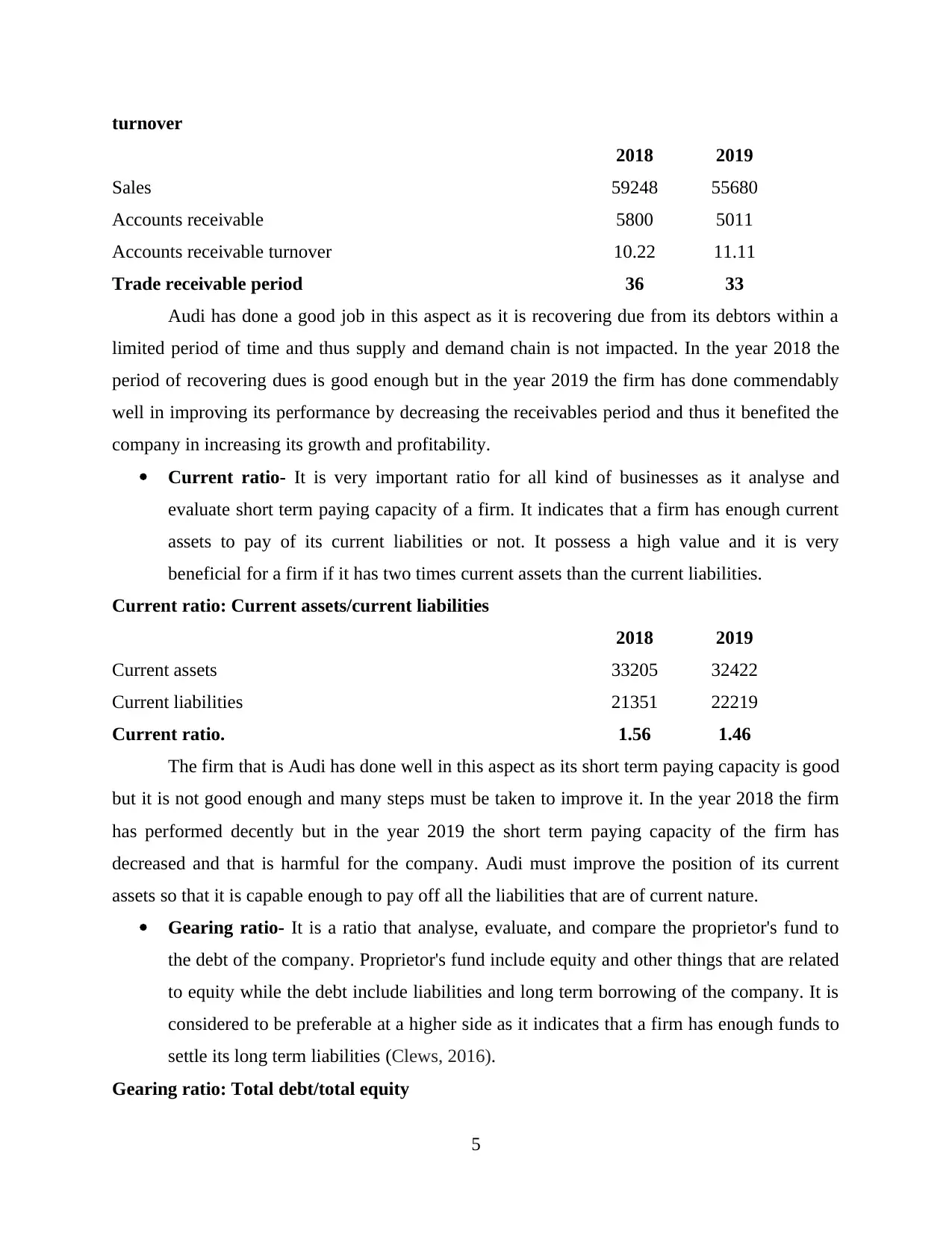
turnover
2018 2019
Sales 59248 55680
Accounts receivable 5800 5011
Accounts receivable turnover 10.22 11.11
Trade receivable period 36 33
Audi has done a good job in this aspect as it is recovering due from its debtors within a
limited period of time and thus supply and demand chain is not impacted. In the year 2018 the
period of recovering dues is good enough but in the year 2019 the firm has done commendably
well in improving its performance by decreasing the receivables period and thus it benefited the
company in increasing its growth and profitability.
Current ratio- It is very important ratio for all kind of businesses as it analyse and
evaluate short term paying capacity of a firm. It indicates that a firm has enough current
assets to pay of its current liabilities or not. It possess a high value and it is very
beneficial for a firm if it has two times current assets than the current liabilities.
Current ratio: Current assets/current liabilities
2018 2019
Current assets 33205 32422
Current liabilities 21351 22219
Current ratio. 1.56 1.46
The firm that is Audi has done well in this aspect as its short term paying capacity is good
but it is not good enough and many steps must be taken to improve it. In the year 2018 the firm
has performed decently but in the year 2019 the short term paying capacity of the firm has
decreased and that is harmful for the company. Audi must improve the position of its current
assets so that it is capable enough to pay off all the liabilities that are of current nature.
Gearing ratio- It is a ratio that analyse, evaluate, and compare the proprietor's fund to
the debt of the company. Proprietor's fund include equity and other things that are related
to equity while the debt include liabilities and long term borrowing of the company. It is
considered to be preferable at a higher side as it indicates that a firm has enough funds to
settle its long term liabilities (Clews, 2016).
Gearing ratio: Total debt/total equity
5
2018 2019
Sales 59248 55680
Accounts receivable 5800 5011
Accounts receivable turnover 10.22 11.11
Trade receivable period 36 33
Audi has done a good job in this aspect as it is recovering due from its debtors within a
limited period of time and thus supply and demand chain is not impacted. In the year 2018 the
period of recovering dues is good enough but in the year 2019 the firm has done commendably
well in improving its performance by decreasing the receivables period and thus it benefited the
company in increasing its growth and profitability.
Current ratio- It is very important ratio for all kind of businesses as it analyse and
evaluate short term paying capacity of a firm. It indicates that a firm has enough current
assets to pay of its current liabilities or not. It possess a high value and it is very
beneficial for a firm if it has two times current assets than the current liabilities.
Current ratio: Current assets/current liabilities
2018 2019
Current assets 33205 32422
Current liabilities 21351 22219
Current ratio. 1.56 1.46
The firm that is Audi has done well in this aspect as its short term paying capacity is good
but it is not good enough and many steps must be taken to improve it. In the year 2018 the firm
has performed decently but in the year 2019 the short term paying capacity of the firm has
decreased and that is harmful for the company. Audi must improve the position of its current
assets so that it is capable enough to pay off all the liabilities that are of current nature.
Gearing ratio- It is a ratio that analyse, evaluate, and compare the proprietor's fund to
the debt of the company. Proprietor's fund include equity and other things that are related
to equity while the debt include liabilities and long term borrowing of the company. It is
considered to be preferable at a higher side as it indicates that a firm has enough funds to
settle its long term liabilities (Clews, 2016).
Gearing ratio: Total debt/total equity
5
Paraphrase This Document
Need a fresh take? Get an instant paraphrase of this document with our AI Paraphraser
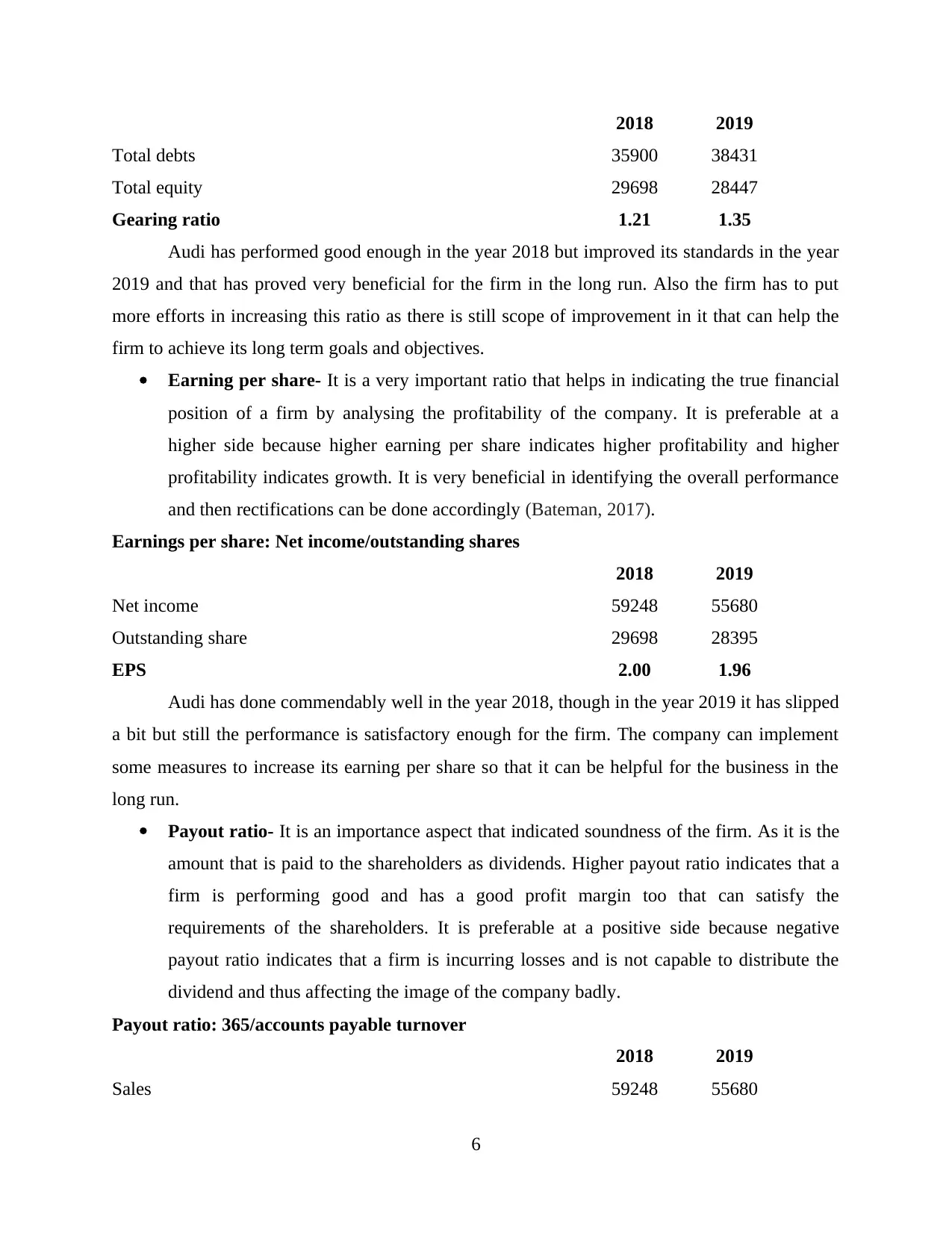
2018 2019
Total debts 35900 38431
Total equity 29698 28447
Gearing ratio 1.21 1.35
Audi has performed good enough in the year 2018 but improved its standards in the year
2019 and that has proved very beneficial for the firm in the long run. Also the firm has to put
more efforts in increasing this ratio as there is still scope of improvement in it that can help the
firm to achieve its long term goals and objectives.
Earning per share- It is a very important ratio that helps in indicating the true financial
position of a firm by analysing the profitability of the company. It is preferable at a
higher side because higher earning per share indicates higher profitability and higher
profitability indicates growth. It is very beneficial in identifying the overall performance
and then rectifications can be done accordingly (Bateman, 2017).
Earnings per share: Net income/outstanding shares
2018 2019
Net income 59248 55680
Outstanding share 29698 28395
EPS 2.00 1.96
Audi has done commendably well in the year 2018, though in the year 2019 it has slipped
a bit but still the performance is satisfactory enough for the firm. The company can implement
some measures to increase its earning per share so that it can be helpful for the business in the
long run.
Payout ratio- It is an importance aspect that indicated soundness of the firm. As it is the
amount that is paid to the shareholders as dividends. Higher payout ratio indicates that a
firm is performing good and has a good profit margin too that can satisfy the
requirements of the shareholders. It is preferable at a positive side because negative
payout ratio indicates that a firm is incurring losses and is not capable to distribute the
dividend and thus affecting the image of the company badly.
Payout ratio: 365/accounts payable turnover
2018 2019
Sales 59248 55680
6
Total debts 35900 38431
Total equity 29698 28447
Gearing ratio 1.21 1.35
Audi has performed good enough in the year 2018 but improved its standards in the year
2019 and that has proved very beneficial for the firm in the long run. Also the firm has to put
more efforts in increasing this ratio as there is still scope of improvement in it that can help the
firm to achieve its long term goals and objectives.
Earning per share- It is a very important ratio that helps in indicating the true financial
position of a firm by analysing the profitability of the company. It is preferable at a
higher side because higher earning per share indicates higher profitability and higher
profitability indicates growth. It is very beneficial in identifying the overall performance
and then rectifications can be done accordingly (Bateman, 2017).
Earnings per share: Net income/outstanding shares
2018 2019
Net income 59248 55680
Outstanding share 29698 28395
EPS 2.00 1.96
Audi has done commendably well in the year 2018, though in the year 2019 it has slipped
a bit but still the performance is satisfactory enough for the firm. The company can implement
some measures to increase its earning per share so that it can be helpful for the business in the
long run.
Payout ratio- It is an importance aspect that indicated soundness of the firm. As it is the
amount that is paid to the shareholders as dividends. Higher payout ratio indicates that a
firm is performing good and has a good profit margin too that can satisfy the
requirements of the shareholders. It is preferable at a positive side because negative
payout ratio indicates that a firm is incurring losses and is not capable to distribute the
dividend and thus affecting the image of the company badly.
Payout ratio: 365/accounts payable turnover
2018 2019
Sales 59248 55680
6
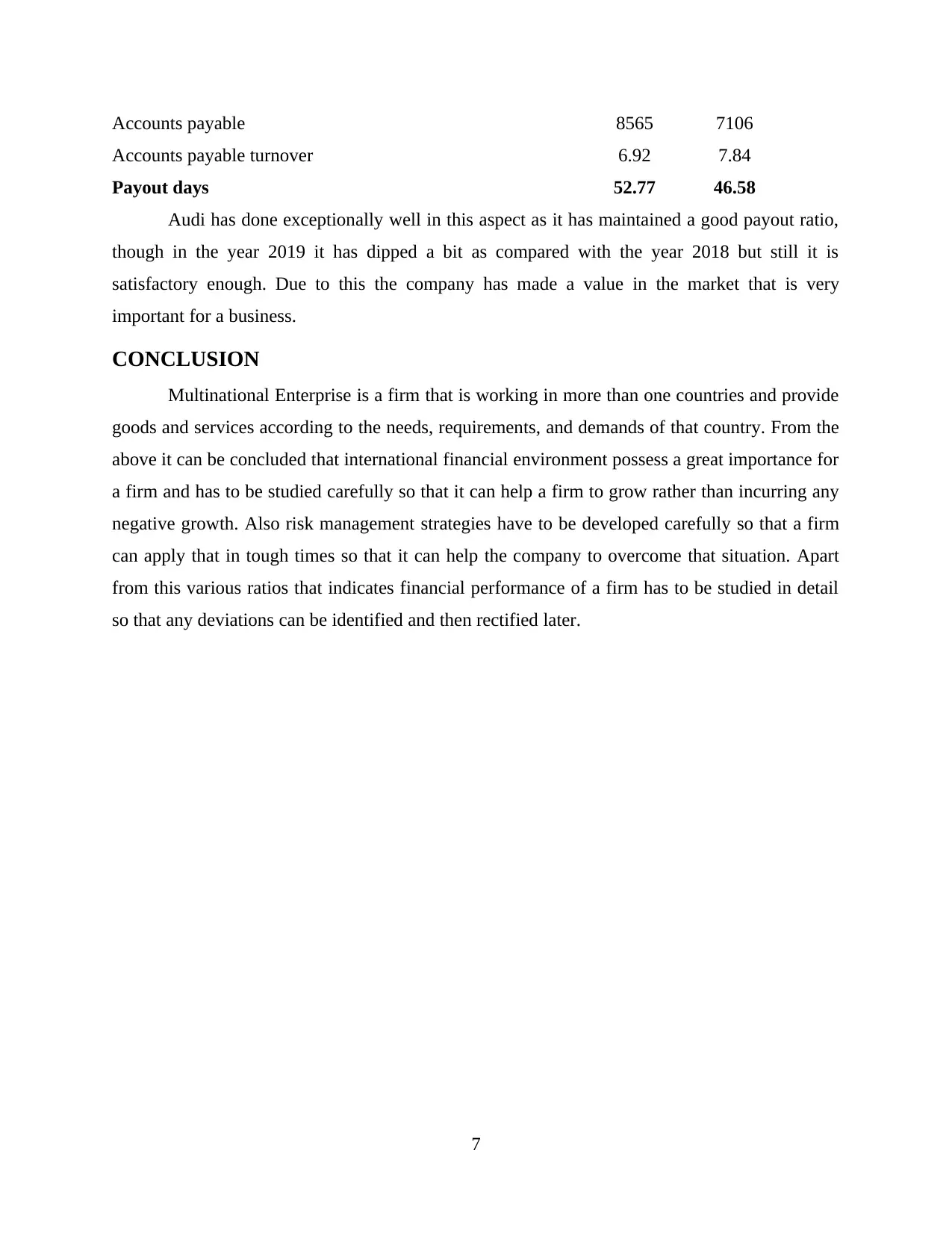
Accounts payable 8565 7106
Accounts payable turnover 6.92 7.84
Payout days 52.77 46.58
Audi has done exceptionally well in this aspect as it has maintained a good payout ratio,
though in the year 2019 it has dipped a bit as compared with the year 2018 but still it is
satisfactory enough. Due to this the company has made a value in the market that is very
important for a business.
CONCLUSION
Multinational Enterprise is a firm that is working in more than one countries and provide
goods and services according to the needs, requirements, and demands of that country. From the
above it can be concluded that international financial environment possess a great importance for
a firm and has to be studied carefully so that it can help a firm to grow rather than incurring any
negative growth. Also risk management strategies have to be developed carefully so that a firm
can apply that in tough times so that it can help the company to overcome that situation. Apart
from this various ratios that indicates financial performance of a firm has to be studied in detail
so that any deviations can be identified and then rectified later.
7
Accounts payable turnover 6.92 7.84
Payout days 52.77 46.58
Audi has done exceptionally well in this aspect as it has maintained a good payout ratio,
though in the year 2019 it has dipped a bit as compared with the year 2018 but still it is
satisfactory enough. Due to this the company has made a value in the market that is very
important for a business.
CONCLUSION
Multinational Enterprise is a firm that is working in more than one countries and provide
goods and services according to the needs, requirements, and demands of that country. From the
above it can be concluded that international financial environment possess a great importance for
a firm and has to be studied carefully so that it can help a firm to grow rather than incurring any
negative growth. Also risk management strategies have to be developed carefully so that a firm
can apply that in tough times so that it can help the company to overcome that situation. Apart
from this various ratios that indicates financial performance of a firm has to be studied in detail
so that any deviations can be identified and then rectified later.
7
⊘ This is a preview!⊘
Do you want full access?
Subscribe today to unlock all pages.

Trusted by 1+ million students worldwide
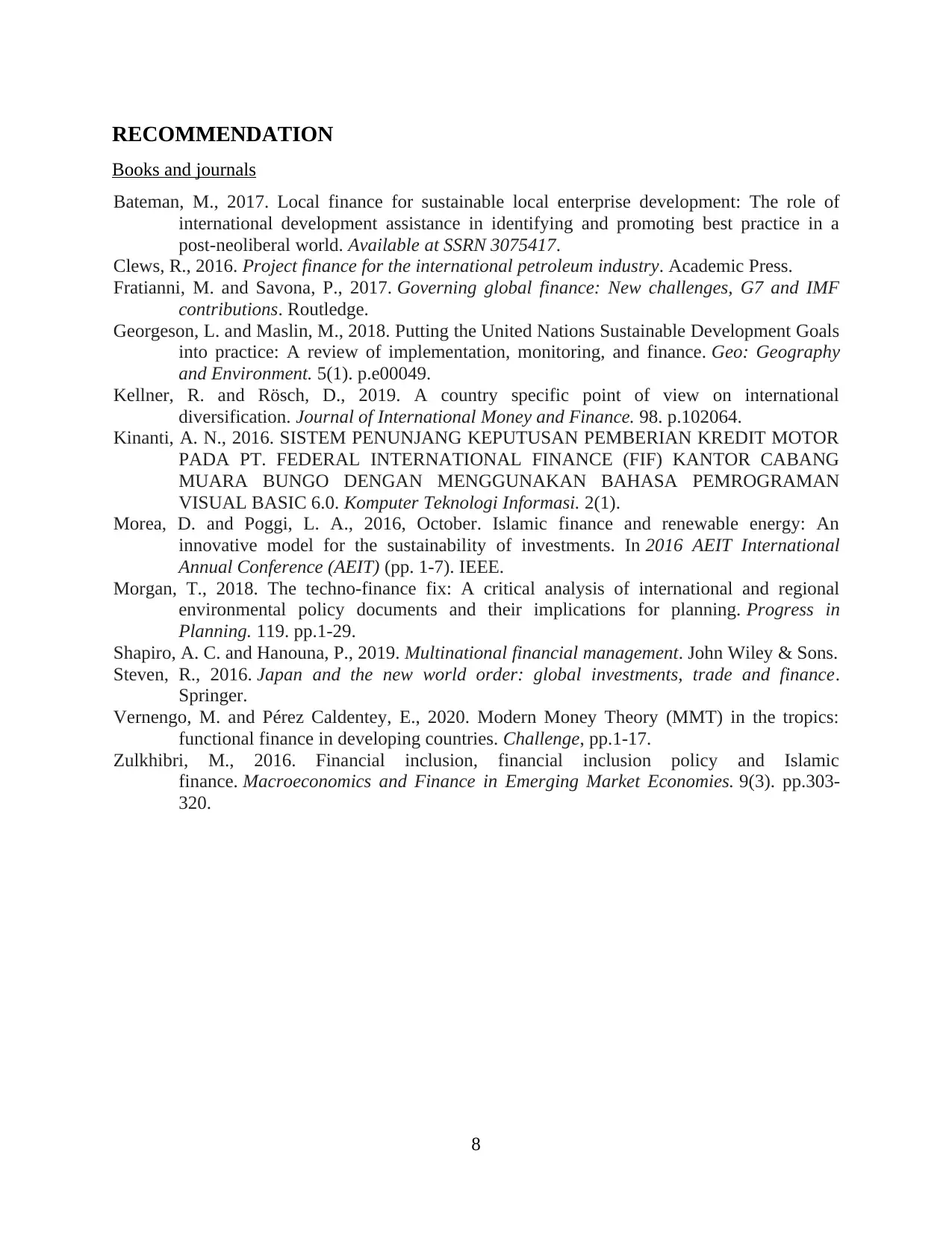
RECOMMENDATION
Books and journals
Bateman, M., 2017. Local finance for sustainable local enterprise development: The role of
international development assistance in identifying and promoting best practice in a
post-neoliberal world. Available at SSRN 3075417.
Clews, R., 2016. Project finance for the international petroleum industry. Academic Press.
Fratianni, M. and Savona, P., 2017. Governing global finance: New challenges, G7 and IMF
contributions. Routledge.
Georgeson, L. and Maslin, M., 2018. Putting the United Nations Sustainable Development Goals
into practice: A review of implementation, monitoring, and finance. Geo: Geography
and Environment. 5(1). p.e00049.
Kellner, R. and Rösch, D., 2019. A country specific point of view on international
diversification. Journal of International Money and Finance. 98. p.102064.
Kinanti, A. N., 2016. SISTEM PENUNJANG KEPUTUSAN PEMBERIAN KREDIT MOTOR
PADA PT. FEDERAL INTERNATIONAL FINANCE (FIF) KANTOR CABANG
MUARA BUNGO DENGAN MENGGUNAKAN BAHASA PEMROGRAMAN
VISUAL BASIC 6.0. Komputer Teknologi Informasi. 2(1).
Morea, D. and Poggi, L. A., 2016, October. Islamic finance and renewable energy: An
innovative model for the sustainability of investments. In 2016 AEIT International
Annual Conference (AEIT) (pp. 1-7). IEEE.
Morgan, T., 2018. The techno-finance fix: A critical analysis of international and regional
environmental policy documents and their implications for planning. Progress in
Planning. 119. pp.1-29.
Shapiro, A. C. and Hanouna, P., 2019. Multinational financial management. John Wiley & Sons.
Steven, R., 2016. Japan and the new world order: global investments, trade and finance.
Springer.
Vernengo, M. and Pérez Caldentey, E., 2020. Modern Money Theory (MMT) in the tropics:
functional finance in developing countries. Challenge, pp.1-17.
Zulkhibri, M., 2016. Financial inclusion, financial inclusion policy and Islamic
finance. Macroeconomics and Finance in Emerging Market Economies. 9(3). pp.303-
320.
8
Books and journals
Bateman, M., 2017. Local finance for sustainable local enterprise development: The role of
international development assistance in identifying and promoting best practice in a
post-neoliberal world. Available at SSRN 3075417.
Clews, R., 2016. Project finance for the international petroleum industry. Academic Press.
Fratianni, M. and Savona, P., 2017. Governing global finance: New challenges, G7 and IMF
contributions. Routledge.
Georgeson, L. and Maslin, M., 2018. Putting the United Nations Sustainable Development Goals
into practice: A review of implementation, monitoring, and finance. Geo: Geography
and Environment. 5(1). p.e00049.
Kellner, R. and Rösch, D., 2019. A country specific point of view on international
diversification. Journal of International Money and Finance. 98. p.102064.
Kinanti, A. N., 2016. SISTEM PENUNJANG KEPUTUSAN PEMBERIAN KREDIT MOTOR
PADA PT. FEDERAL INTERNATIONAL FINANCE (FIF) KANTOR CABANG
MUARA BUNGO DENGAN MENGGUNAKAN BAHASA PEMROGRAMAN
VISUAL BASIC 6.0. Komputer Teknologi Informasi. 2(1).
Morea, D. and Poggi, L. A., 2016, October. Islamic finance and renewable energy: An
innovative model for the sustainability of investments. In 2016 AEIT International
Annual Conference (AEIT) (pp. 1-7). IEEE.
Morgan, T., 2018. The techno-finance fix: A critical analysis of international and regional
environmental policy documents and their implications for planning. Progress in
Planning. 119. pp.1-29.
Shapiro, A. C. and Hanouna, P., 2019. Multinational financial management. John Wiley & Sons.
Steven, R., 2016. Japan and the new world order: global investments, trade and finance.
Springer.
Vernengo, M. and Pérez Caldentey, E., 2020. Modern Money Theory (MMT) in the tropics:
functional finance in developing countries. Challenge, pp.1-17.
Zulkhibri, M., 2016. Financial inclusion, financial inclusion policy and Islamic
finance. Macroeconomics and Finance in Emerging Market Economies. 9(3). pp.303-
320.
8
Paraphrase This Document
Need a fresh take? Get an instant paraphrase of this document with our AI Paraphraser
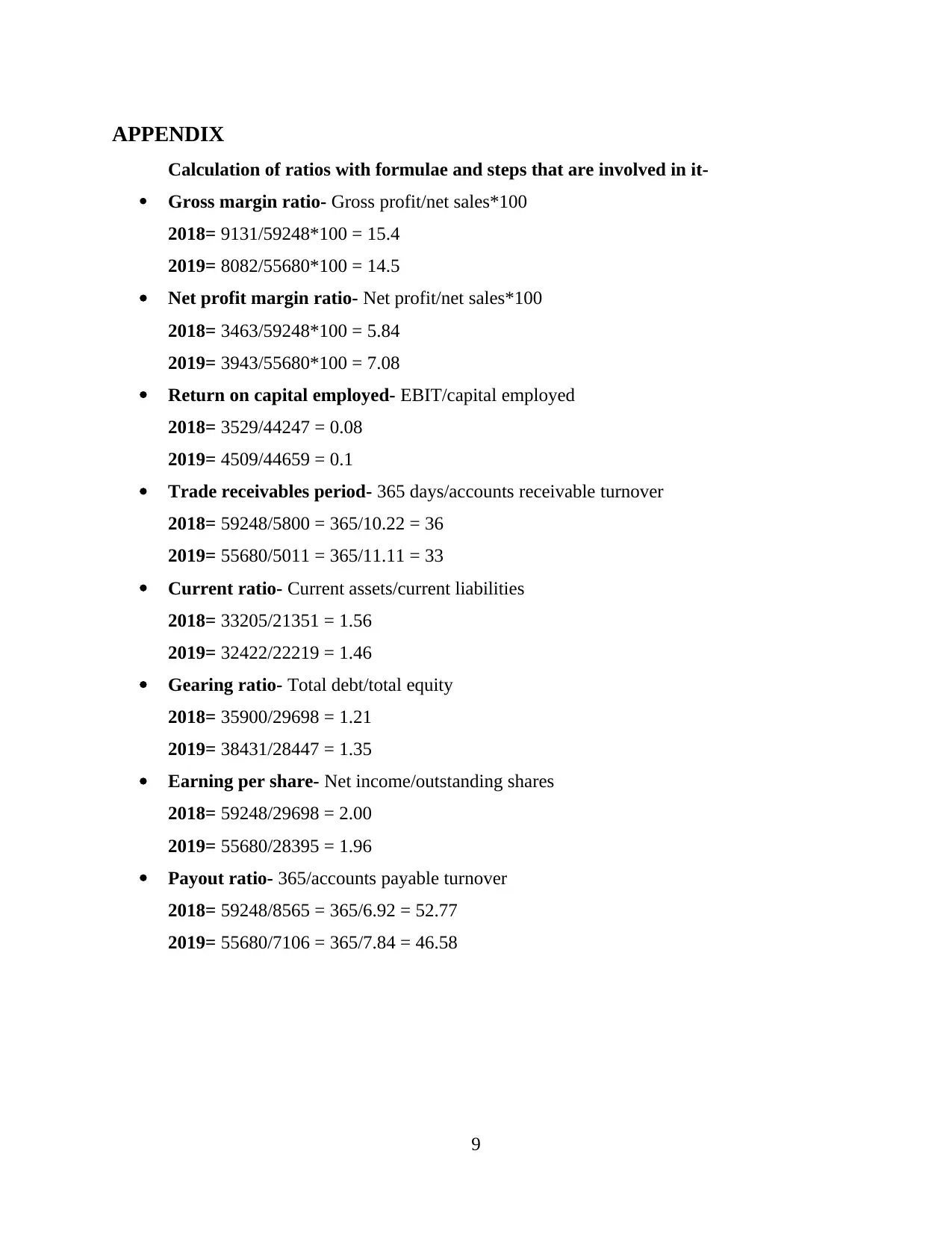
APPENDIX
Calculation of ratios with formulae and steps that are involved in it-
Gross margin ratio- Gross profit/net sales*100
2018= 9131/59248*100 = 15.4
2019= 8082/55680*100 = 14.5
Net profit margin ratio- Net profit/net sales*100
2018= 3463/59248*100 = 5.84
2019= 3943/55680*100 = 7.08
Return on capital employed- EBIT/capital employed
2018= 3529/44247 = 0.08
2019= 4509/44659 = 0.1
Trade receivables period- 365 days/accounts receivable turnover
2018= 59248/5800 = 365/10.22 = 36
2019= 55680/5011 = 365/11.11 = 33
Current ratio- Current assets/current liabilities
2018= 33205/21351 = 1.56
2019= 32422/22219 = 1.46
Gearing ratio- Total debt/total equity
2018= 35900/29698 = 1.21
2019= 38431/28447 = 1.35
Earning per share- Net income/outstanding shares
2018= 59248/29698 = 2.00
2019= 55680/28395 = 1.96
Payout ratio- 365/accounts payable turnover
2018= 59248/8565 = 365/6.92 = 52.77
2019= 55680/7106 = 365/7.84 = 46.58
9
Calculation of ratios with formulae and steps that are involved in it-
Gross margin ratio- Gross profit/net sales*100
2018= 9131/59248*100 = 15.4
2019= 8082/55680*100 = 14.5
Net profit margin ratio- Net profit/net sales*100
2018= 3463/59248*100 = 5.84
2019= 3943/55680*100 = 7.08
Return on capital employed- EBIT/capital employed
2018= 3529/44247 = 0.08
2019= 4509/44659 = 0.1
Trade receivables period- 365 days/accounts receivable turnover
2018= 59248/5800 = 365/10.22 = 36
2019= 55680/5011 = 365/11.11 = 33
Current ratio- Current assets/current liabilities
2018= 33205/21351 = 1.56
2019= 32422/22219 = 1.46
Gearing ratio- Total debt/total equity
2018= 35900/29698 = 1.21
2019= 38431/28447 = 1.35
Earning per share- Net income/outstanding shares
2018= 59248/29698 = 2.00
2019= 55680/28395 = 1.96
Payout ratio- 365/accounts payable turnover
2018= 59248/8565 = 365/6.92 = 52.77
2019= 55680/7106 = 365/7.84 = 46.58
9

10
⊘ This is a preview!⊘
Do you want full access?
Subscribe today to unlock all pages.

Trusted by 1+ million students worldwide
1 out of 12
Related Documents
Your All-in-One AI-Powered Toolkit for Academic Success.
+13062052269
info@desklib.com
Available 24*7 on WhatsApp / Email
![[object Object]](/_next/static/media/star-bottom.7253800d.svg)
Unlock your academic potential
Copyright © 2020–2025 A2Z Services. All Rights Reserved. Developed and managed by ZUCOL.




